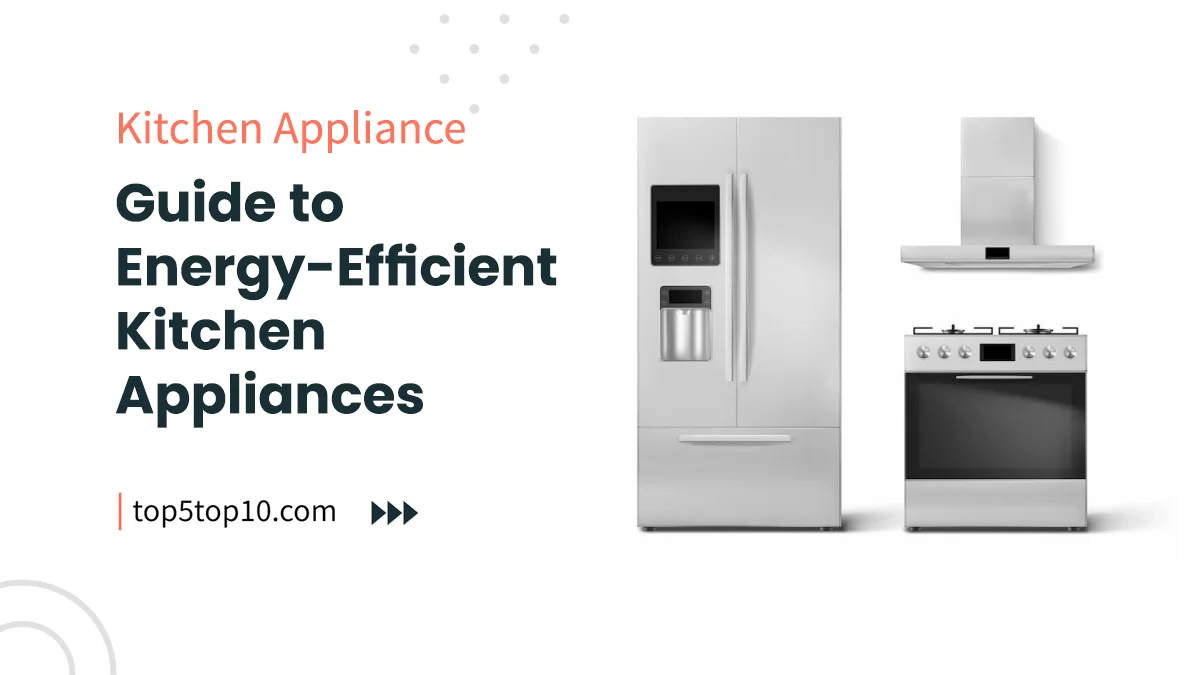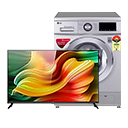
Guide to Selecting Energy-Efficient Kitchen Appliances – In today’s world, where environmental consciousness and energy conservation are crucial, selecting energy-efficient kitchen appliances is a responsible and economical choice.
Efficient appliances not only help reduce your carbon footprint but also lower utility bills.
This comprehensive guide will walk you through the process of choosing energy-efficient kitchen appliances, understanding their benefits, and making informed decisions.
Contents
- 1. Understanding Energy Efficiency
- 2. Identifying Energy-Efficient Appliances
- 3. Key Kitchen Appliances to Consider
- 4. Energy-Efficient Kitchen Design Tips
- 5. Budget Considerations and Return on Investment
- 6. Tips for Making Informed Choices
- 7. Conclusion
- 8. References and Resources
- Guide to Selecting Energy-Efficient Kitchen Appliances FAQs
1. Understanding Energy Efficiency
A. What Is Energy Efficiency?
Energy efficiency refers to the ability of appliances to perform their functions while consuming the least amount of energy possible.
It’s a measure of how effectively an appliance converts energy into useful work, whether it’s cooling food, heating water, or cooking meals.
Inefficient appliances waste energy and contribute to higher energy bills and increased environmental impact.
B. Why Energy Efficiency Matters in Kitchen Appliances
The kitchen is one of the most energy-intensive areas in a home due to the use of appliances like refrigerators, ovens, dishwashers, and more. Choosing energy-efficient kitchen appliances can:
- Lower electricity bills over time.
- Reduce greenhouse gas emissions.
- Decrease the demand on energy resources.
- Extend the lifespan of appliances.
- Enhance the overall sustainability of your home.
C. The Benefits of Choosing Energy-Efficient Appliances
Selecting energy-efficient kitchen appliances offers several advantages:
- Cost Savings: Energy-efficient appliances typically consume less electricity, leading to reduced utility bills.
- Environmental Impact: Lower energy consumption reduces carbon emissions, helping combat climate change.
- Longevity: Energy-efficient appliances are often built to higher standards, resulting in longer lifespans and fewer replacements.
- Improved Performance: Modern energy-efficient appliances are designed to offer excellent performance while conserving energy.
2. Identifying Energy-Efficient Appliances
A. Energy Star Certification
1. What Is Energy Star?
Energy Star is a widely recognized program that identifies and promotes energy-efficient products, including kitchen appliances.
Appliances bearing the Energy Star label meet or exceed strict energy efficiency guidelines set by the U.S. Environmental Protection Agency (EPA) and the U.S. Department of Energy (DOE).
2. The Significance of Energy Star Certification
Choosing Energy Star-certified kitchen appliances ensures that you are investing in products known for their energy efficiency and environmental responsibility.
Energy Star appliances are rigorously tested to meet stringent standards, resulting in significant energy and cost savings.
B. Energy Labels and Ratings
Apart from the Energy Star label, various energy labels and ratings are used worldwide to signify the energy efficiency of appliances.
These labels provide valuable information about an appliance’s energy performance.
C. Recognizing Energy-Efficient Features
To identify energy-efficient kitchen appliances, look for the following features:
1. Insulation and Seals
Efficient appliances have high-quality insulation and seals that prevent temperature leakage. This reduces the need for the appliance to work harder to maintain the desired temperature.
2. Efficient Cooling and Heating Systems
Modern refrigerators, ovens, and stovetops are equipped with advanced cooling and heating systems that optimize energy use while delivering excellent performance.
3. Energy-Saving Modes
Many appliances have energy-saving or “eco” modes that reduce energy consumption during periods of inactivity or low use.
4. Smart Technology Integration
Smart appliances often include features that allow you to monitor and control energy consumption through smartphone apps. They can also adapt to your usage patterns, optimizing energy efficiency.
3. Key Kitchen Appliances to Consider
When it comes to energy efficiency, specific kitchen appliances play a more significant role. Let’s explore some of the essential ones and what to look for in each:
A. Refrigerators and Freezers
Refrigerators and freezers are among the most power-hungry kitchen appliances. When shopping for an energy-efficient refrigerator or freezer, consider the following:
1. Importance of Proper Sizing
Choose a refrigerator or freezer that matches your family’s needs. An oversized appliance will consume more energy than necessary, while an undersized one may struggle to keep your food fresh.
2. Features to Look for in an Energy-Efficient Fridge
| Energy-Efficient Features | Description |
|---|---|
| Dual Evaporator System | Separately cools the fresh food and freezer sections, improving efficiency. |
| LED Lighting | Energy-efficient and long-lasting lighting. |
| Smart Technology | Allows for remote monitoring and control, optimizing energy use. |
| Efficient Compressors | Advanced compressors consume less energy while maintaining temperature. |
B. Dishwashers
Dishwashers can be significant energy consumers in the kitchen. Look for the following when choosing an energy-efficient dishwasher:
1. Water Efficiency and Energy Star Ratings
Select a dishwasher with high water efficiency and an Energy Star rating. Modern dishwashers use less water and energy while achieving excellent cleaning results.
2. Advanced Dishwasher Features
| Energy-Efficient Features | Description |
|---|---|
| Soil Sensors | Adjust water and energy usage based on the level of soiling. |
| Delay Start | Allows you to schedule wash cycles during off-peak hours. |
| Efficient Spray Arms | Optimize water distribution for thorough cleaning with less water. |
| Heat Exchangers | Use residual heat for water heating, reducing energy consumption. |
C. Cooking Appliances
Cooking appliances like ranges, ovens, microwaves, and cooktops are essential in every kitchen. Consider the following energy-efficient options:
1. Ranges and Ovens
| Energy-Efficient Features | Description |
|---|---|
| Convection Cooking | Circulates hot air for faster and more even cooking, reducing cook times. |
| Induction Cooktops | Use electromagnetic fields to heat cookware directly, reducing energy waste. |
| Self-Cleaning Options | Some self-cleaning modes are more energy-efficient than others. |
| Delay Start | Allows for preheating the oven just before you need it, saving energy. |
| Energy-Efficient Features | Description |
|---|---|
| Inverter Technology | Delivers precise and even heating, reducing cook times and energy consumption. |
| Sensor Cooking | Adjusts cooking time and power based on food moisture and temperature, preventing overcooking. |
| Efficient Door Seals | Ensures minimal heat loss during operation. |
D. Small Kitchen Appliances
Even small kitchen appliances like coffee makers, toasters, ovens, blenders, and food processors can benefit from energy-efficient design and features.
| Energy-Efficient Features | Description |
|---|---|
| Thermal Carafes | Keeps coffee hot without the need for a heating plate. |
| Auto-Off Function | Shuts off the coffee maker after a set period of inactivity. |
2. Toasters and Ovens
| Energy-Efficient Features | Description |
|---|---|
| Efficient Heating Elements | Use advanced heating elements that reach the desired temperature quickly. |
| Auto-Shutoff Timers | Automatically turn off after a specified time. |
3. Blenders and Food Processors
| Energy-Efficient Features | Description |
|---|---|
| High-Powered Motors | Blend or process ingredients quickly, reducing operating time. |
| Efficient Blades | Optimize blending or chopping efficiency. |
4. Energy-Efficient Kitchen Design Tips
In addition to selecting energy-efficient appliances, the layout and design of your kitchen can contribute to energy savings.
1. Proper Kitchen Layout and Appliance Placement
Design your kitchen layout to minimize unnecessary movements. Place appliances strategically to reduce heat buildup and improve workflow.
2. Efficient Lighting
Use energy-efficient LED or CFL (compact fluorescent lamp) lighting throughout your kitchen.
Consider motion sensors or timers to ensure lights are not left on when not needed.
3. Ventilation and Range Hoods
Install efficient range hoods and use them when cooking to remove heat, odors, and moisture.
Choose models with variable-speed fans to reduce energy use when maximum ventilation isn’t necessary.
4. Maintenance and Regular Upkeep
Regularly clean and maintain your appliances to ensure they operate at peak efficiency. Replace worn-out seals, clean filters, and schedule professional maintenance as needed.
5. Budget Considerations and Return on Investment
1. Upfront Costs vs. Long-Term Savings
Energy-efficient appliances may have a slightly higher upfront cost than standard models, but the long-term savings in reduced energy bills often outweigh the initial investment.
2. Government Incentives and Rebates
Check for government incentives, tax credits, or rebates for purchasing energy-efficient appliances. These programs can significantly reduce the overall cost.
3. Calculating Potential Savings Over Time
Consider the lifetime cost of ownership when evaluating appliances. Calculate potential energy savings over the appliance’s lifespan to understand the true value of energy efficiency.
6. Tips for Making Informed Choices
1. Assessing Your Kitchen Needs and Habits
Consider your family’s cooking habits, the size of your household, and your kitchen’s layout when selecting energy-efficient appliances.
2. Researching Brands and Models
Explore reputable appliance brands and models known for their energy efficiency. Read reviews and seek recommendations from experts and peers.
3. Reading User Reviews
User reviews can provide valuable insights into the real-world performance and energy efficiency of appliances. Look for feedback from users who have owned the appliance for an extended period.
4. Consulting with Appliance Experts
If you’re unsure about which appliances are best for your kitchen and needs, consult with appliance experts or kitchen designers who can provide personalized recommendations.
7. Conclusion
Selecting energy-efficient kitchen appliances is a responsible choice that benefits both your wallet and the environment. By understanding what makes an appliance energy-efficient, choosing the right features, and considering factors like size and layout, you can create an eco-friendly and cost-effective kitchen.
As technology continues to advance, energy-efficient appliances are becoming more accessible and affordable, making it easier than ever to reduce your carbon footprint while enjoying the convenience of modern kitchen appliances.
8. References and Resources
To further assist you in selecting energy-efficient kitchen appliances, consult the following references and resources:
Guide to Selecting Energy-Efficient Kitchen Appliances FAQs
What are the benefits of selecting energy-efficient kitchen appliances?
Energy-efficient kitchen appliances offer several benefits, including reduced energy consumption, lower utility bills, reduced environmental impact, and often superior performance.
They can help you save money while minimizing your carbon footprint.
How can I identify energy-efficient kitchen appliances when shopping?
Look for appliances with the ENERGY STAR label.
This label indicates that the appliance meets specific energy efficiency standards set by the Environmental Protection Agency (EPA) in the United States.
ENERGY STAR appliances are designed to use less energy while delivering top-notch performance.
What should I consider when selecting energy-efficient appliances for my kitchen?
When choosing energy-efficient appliances, consider factors like the appliance type, size, features, and your specific needs.
Look for models with energy-saving options, such as adjustable temperature settings, efficient cooling and heating systems, and high-quality insulation.
How do energy-efficient appliances help reduce electricity consumption?
Energy-efficient appliances reduce electricity consumption by using advanced technologies, better insulation, and optimized designs.
For example, refrigerators and freezers with improved insulation maintain consistent temperatures, while energy-efficient cooking appliances heat up quickly and retain heat efficiently.
Are energy-efficient appliances more expensive than regular ones?
Energy-efficient appliances may have a slightly higher upfront cost, but they typically save you money in the long run due to reduced energy consumption.
Additionally, many governments offer rebates or incentives for purchasing energy-efficient appliances, further offsetting the initial investment.
|
Related Tags
Guide to selecting energy efficient kitchen appliances pdf, energy-efficient appliances list, energy-efficient kitchen appliances cost, energy efficiency class g meaning, energy efficiency rating appliances, new energy ratings compared to old, new energy ratings for appliances, how is the energy efficiency ratio related to the operatin











